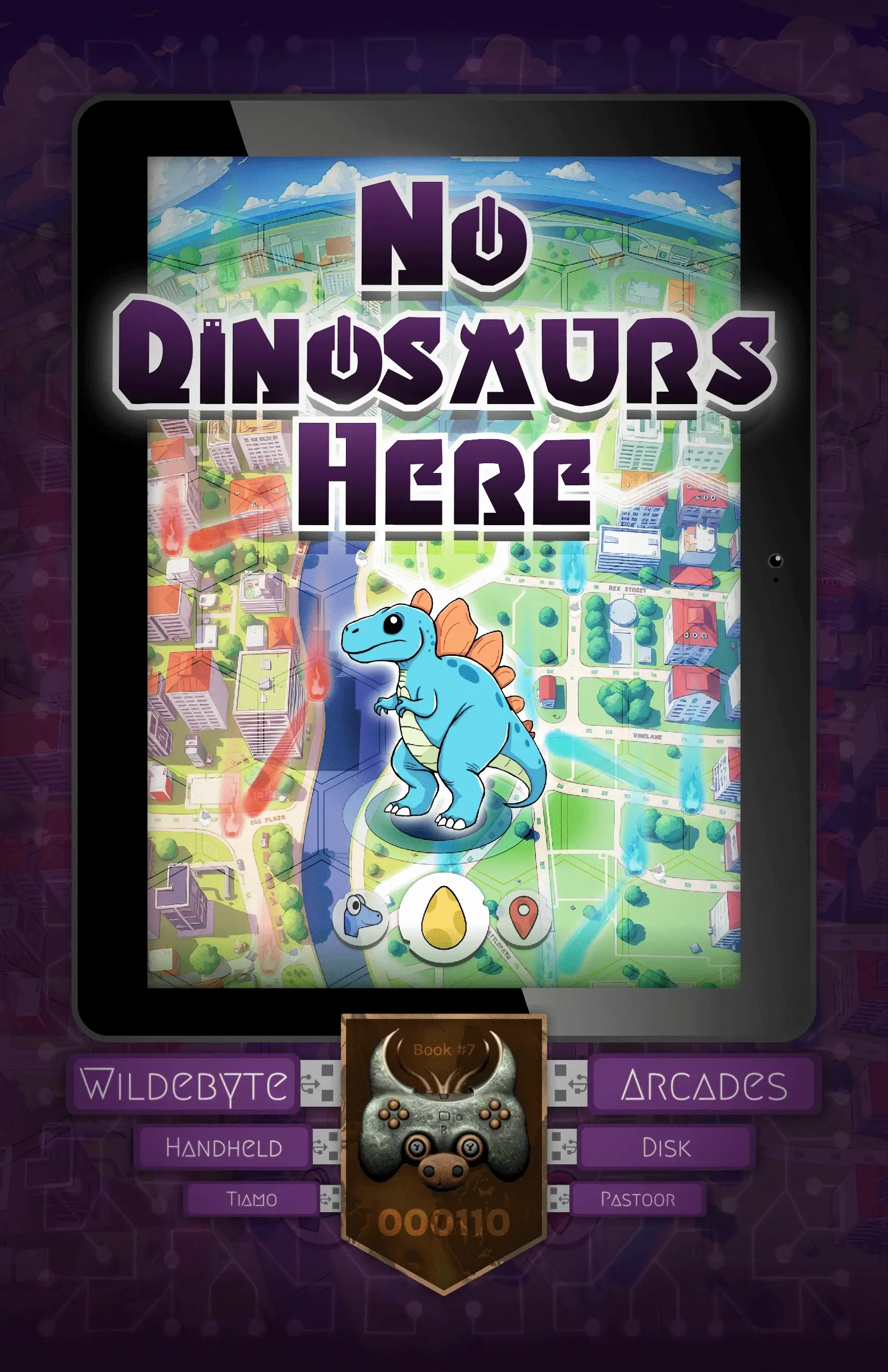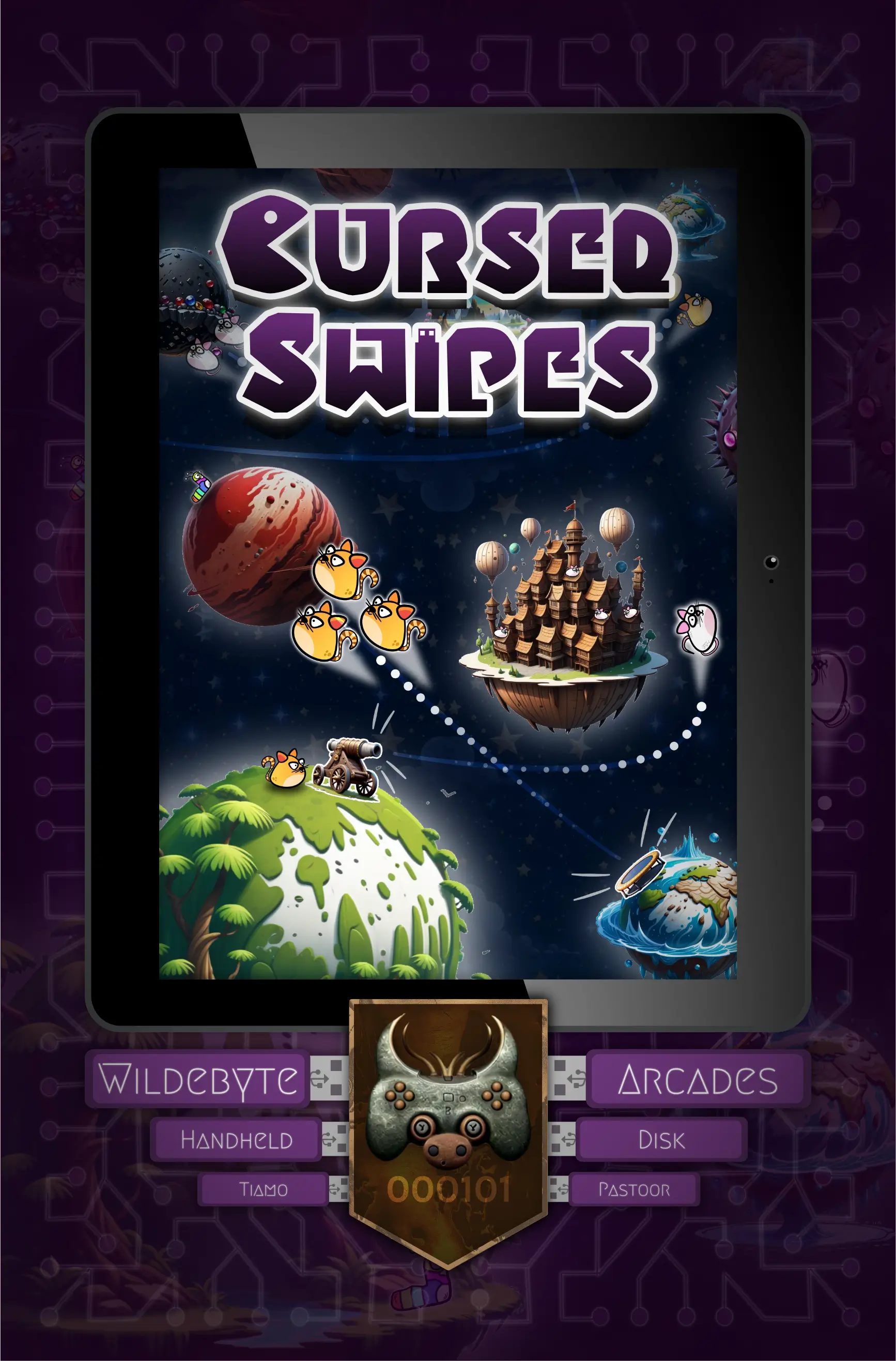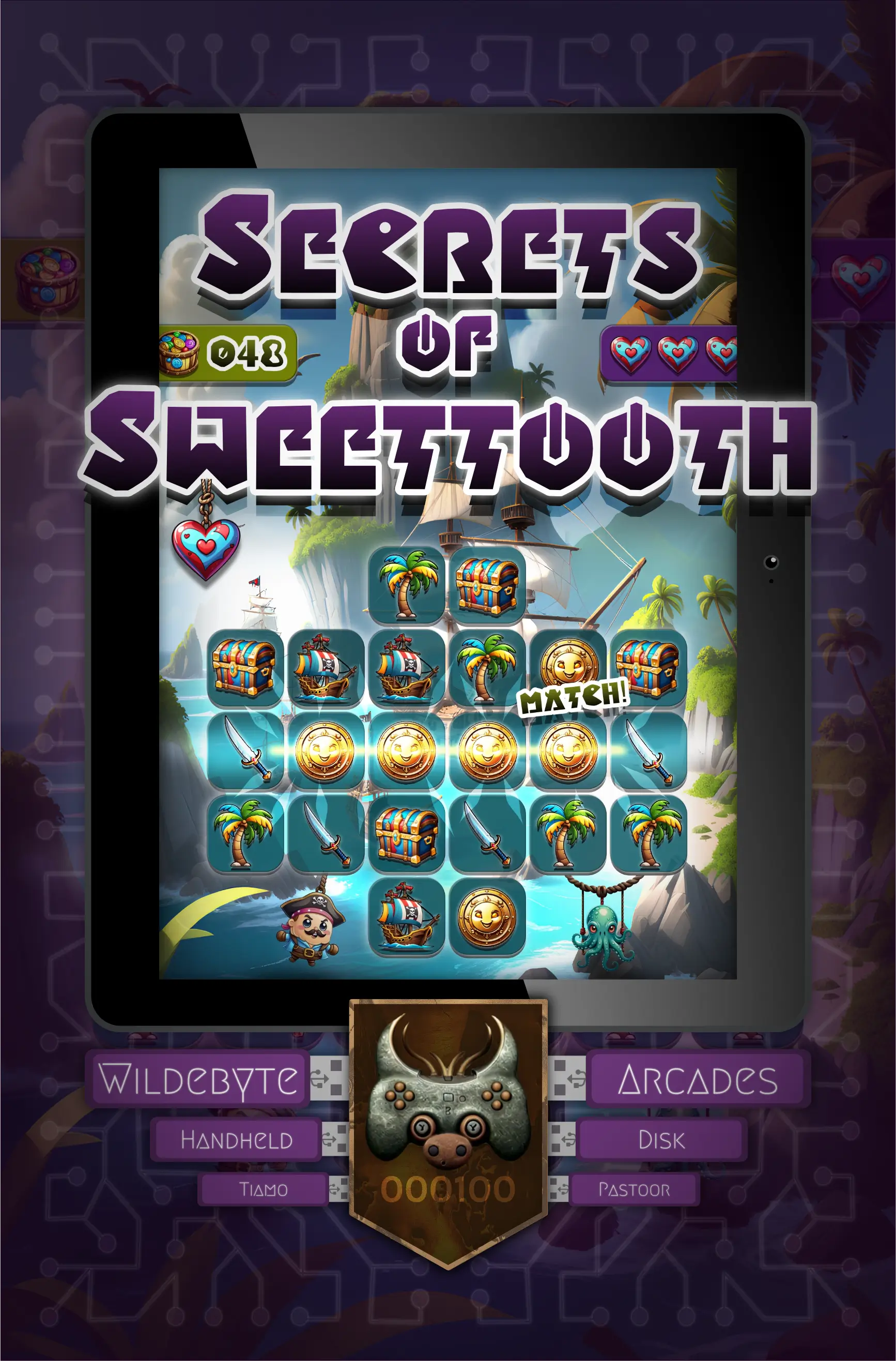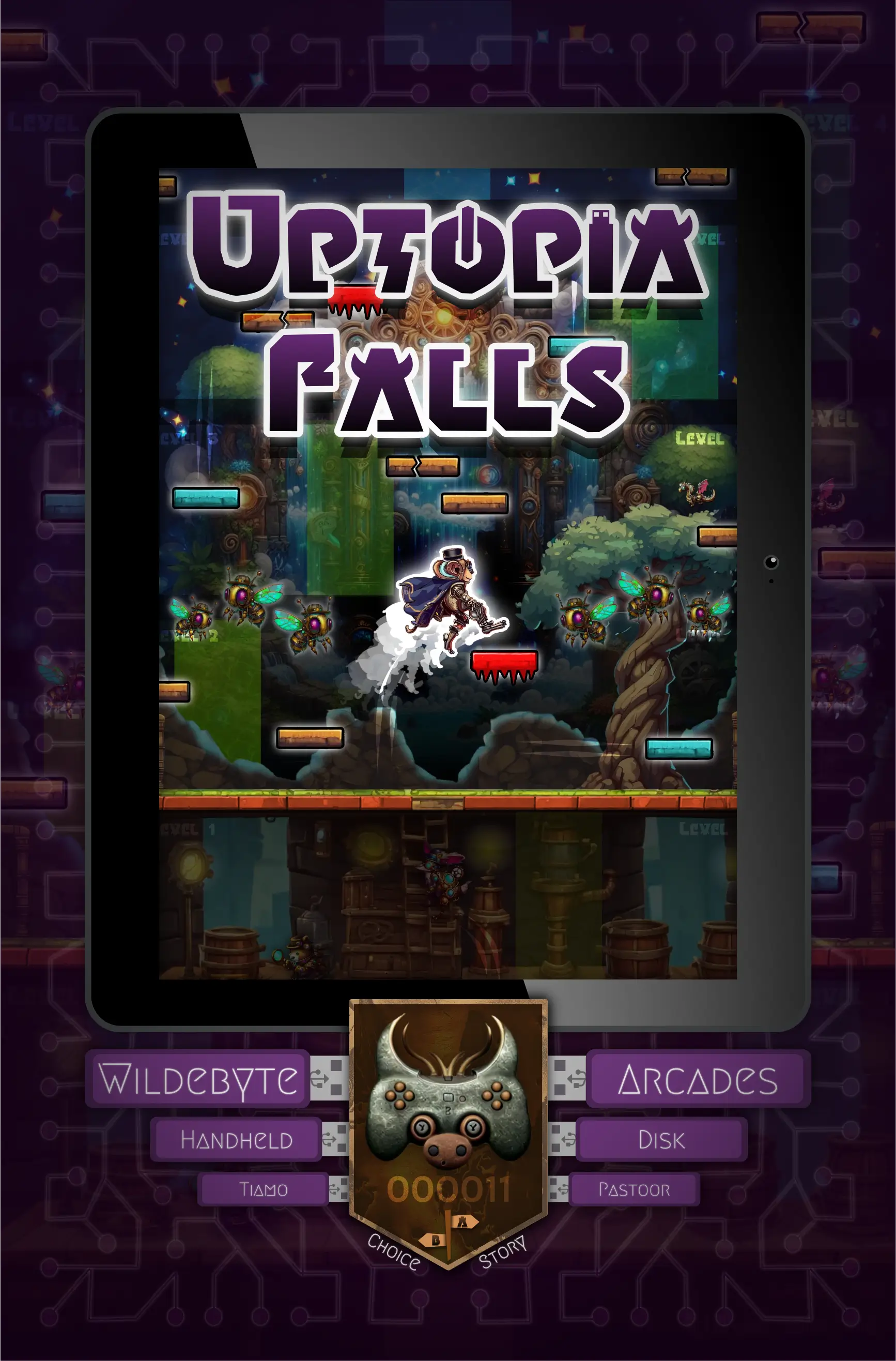Welcome to the writing diary for my book No Dinosaurs Here. In this article, I keep track of the general process for writing this book, and hopefully share some interesting or fun elements along the way.
As always, SPOILERS for this book (and very light spoilers for other books before it).
What’s the idea?
Originally, this game idea was at position ~15 in this disk. It’s a tough game to turn into a story, and it’s not the most popular or common.
This book is about games like Pokémon Go and Ingress. GPS-based, Augmented-Reality games.
But then a few things happened.
- I realized a few ways in which this could actually turn into a GREAT story.
- I realized this also makes the book very unique and different from all that came before, which seemed more valuable to me now. (Other ideas before this one were pushed BACk because they were so similar to books planned just before it.)
- I figured out the “game design lesson” to attach to it that completed the idea.
So now it’s pushed all the way to the front. Let’s explore what I mean with the points mentioned above.
Turning it into story
This is a GPS-based game. That means we can actually … visit important locations in the real world in this book!
- Wildebyte’s home
- The President’s home
- Perhaps Ingar’s headquarters
- The game can connect to nearby people (playing the same game)
- Etcetera
Through telling the story, we can give a lot of extra information and cool tidbits about what’s going on in the real world.
In a sense, this story would only be 50% about the game, and 50% about the outside world. (The most of any story, as far as I can see now.)
Additionally, this created the possibility for a story idea like this:
- This game is, as always, just a little different. When it was created, the developers placed/hid all content there will ever be in the real world. There’s never going to be more—it’s all out there for players to find and claim.
- There’s a true battle raging in the real world. A group of people is overwhelming the neighborhood, taking all the good spots, adding bad items to the game, etcetera. This obviously narrows what Wildebyte can do and the Player must travel further and further (in the real world) to be able to do anything anymore.
- This is like a virus growing in the augmented world.
- And, because of the rule I mentioned above, this actually matters. If that virus grows too large, it swallows all other players/items and renders the game “done”.
- Somebody is leaving important seeds, or eggs, or items behind. Over time, Wildebyte realizes all of these are at locations that matter to them. They are connected to their real life.
- Until they realize that their parents + Ingar are helping them. They hoped he’d enter this game at some point and be able to find those items.
- This wild goose chase (both in-game and in the real world) eventually leads to some remote location, guarded by players from the other group, with the most important item.
- Wildebyte + Player manage to get there and claim the item.
- What does it do? One part is secret, to be revealed in a later book ;) The other part, that ends this story in a satisfying way, is that it finally unlocks new content and makes this Player suddenly a very popular/powerful person in this game.
The idea is that tension comes from the real world. We constantly have the Player visit dangerous locations, remote locations, locations “guarded” by the others, etcetera. We don’t necessarily fear for Wildebyte, we fear for the Player.
That felt new and interesting to me. Hence why this book was pushed to the front.
The Game Design Lesson
The lesson here is that humans are physical beings. Games become much easier to understand and more fun to play if they are attached to something physical, to movement, to something from the real world.
This game exemplifies that. Searching and catching Pokémon is easy to understand and more fun when that is literally what you do in real life. You walk around and throw a ball when near.
Previous books already showed this. Many games are about movement and have realistic physics, because that’s what our brains were made to handle.
But to really drive the point home, we need some secondary storyline about this. (Besides something like Sweettooth complaining that he can’t just “slice this problem in half with his sword!”)
We could make this happen in the real world too. The Player has to solve some really abstract math homework problems or something, and only understands them once they’re explained in that more physical way.
We could do this in-game. Maybe the game is coded in an extremely abstract way, perhaps for “security” and “protection against hacking”.
- This means actions are not taken by walking to them and pressing a button, but in a very non-physical way—like “send a thought beam to coordinates 43,48”.
- It means voice commands are really weird with non-intuitive words.
- It means they made no effort to give things realistic physics or models realistic movement.
- It means a light turning OFF means a feature is ON, and vice versa. Very confusing.
You get the idea.
As usual, I mostly improvise and don’t want a strict planning. So these are the general ideas and approaches, and now I just need to start writing.
And for that, all we need is the first chapter: introduce the general type of game (as mysteriously/fun as possible, perhaps by reconstructing the environment and having some guiding light that represents the GPS), introduce the “virus”, then have WB realize this is their home. (So they want to stay longer and fight the Player who is leaving.)
Let’s write that: Chapters 1–6
So, I wrote chapter 1 months ago. I wanted to be productive, so I wrote chapter 1 for several Wildebyte books in a row in a single day. Don’t question my methods :p
This meant that, when I came back, I already had a solid start … but my mind was also “out of the story” entirely. I had to read back chapter 1, and all my notes, and this devlog, to remember what on earth I was doing.
This made chapter 2 very slow to write/figure out. But once I got back into the groove of things, it all worked out quite nicely.
My original plan for the first chapters could mostly be followed. Some parts I’d planned for later were moved to be explained/shown earlier. For example, the fact that this game is “pay to win” just felt weird to introduce halfway. Surely, such a huge aspect of such a popular game—being able to buy upgrades, better creatures, etcetera—would be well-known to almost all players. So I moved it to this first chunk of chapters.
This meant some other things had to be moved to a later moment, of course, to make space for it. Most notably, I had planned one more quick “scavenger hunt” for an egg and one more explanation about a game mechanic (the “nurturing” or “taking care of” your creatures). This just didn’t fit anymore.
I considered moving the “climax” of the first chunk to chapter 7 instead of 6, but then the story would have gone on too long without some big action sequence or twist. So I kept chapter 6 to be the one that ends in physical conflict and brings the Player to the hospital. Though, because this is such a full chapter now, I might end up breaking it into chapter 6+7 anyway.
(Maybe this is the wrong choice. Who knows. I certainly don’t. But it’s the choice I made.)
The biggest deviation was the fact that Sweettooth and Wildebyte are split up. In fact, we get our first chapter from another character’s perspective: Sweettooth (as expected).
Why?
- Just to do something different. I am easily bored.
- Their inability to stay together and work together is a flaw they must overcome.
- Sweettooth’s whole character is that he is a pirate, who does what he wants and goes after his own stupid goals. At this point, he is more useful and interesting doing his own side quests that eventually link up to the main quest again.
- My original plan had this subplot about helping the Player understand math (intuitively) and get a good grade on an important test. It felt messy to have Wildebyte try to achieve multiple things at once, so it’s cleaner if Sweettooth basically handles this subplot on his own.
Chapters 7-14
Okay, yes, the “climax” of the first chunk that was planned for chapter 6, has basically been spread out over chapter 6, 7, and 8. As it went on, I realized I had much more to say and much more drama to introduce, so this is fine.
The next chunk had planned for Layla to be stuck in hospital, which now feels boring to stretch over 6 chapters anyway. So I just reduced the second chunk to save time.
Initially, I had planned to end this chunk with the big “reveal” that the game is finite. I had planned to show this by the protagonist constantly returning to the same place (which had something the first time, but she caught that and now it’s empty). But it remains empty; nothing grows back.
This, however, means spending a lot of time showing … nothing. Literally. Showing the protagonist visit empty patches of grass with nothing of interest in the game.
So, instead, this issue is revealed through snippets of conversation along the way. I did allow Ingar to make an appearance, in the hospital, to confirm this and be mysterious about why he did this.
Instead, the “climax” of this chunk became something different (and much better, in my opinion):
- At a major battle, her friend loses all she has. The friend who has constantly helped her and saved her is now completely out of the game—and she doesn’t feel like starting up again.
- The Rainbow Egg finally hatches.
At first, this chunk was very vague. But now that the climax was clear, the steps to get there were also clearer:
- Layla gradually regains strength, nurtures the Rainbow Egg, and gets out of the hospital.
- She tries to win back territory and scavenges for the final remaining content of the game (together with her friend)
- Until going too far and her friend losing it all.
As I will explain below, however, some more notes and ideas crashed through my original outline as I wrote this.
This made the chunk 2 chapters longer. This also shifted a lot of the reasons why or specifics how it all happened.
- Rosie (her friend) now loses everything because she tries to capture a Master Den alone. (Because Layla is grounded until she fixes her grades.)
- We spend a little more time developing her relationship with Hugo. I made this more “important” by having the twist that one of the earlier characters is his mother (and a politician), which means the dinner escalates with talks about politics => this sets up what’s to come in chunk 3 better
- The chapter where they visit Ingar’s Headquarters was just too interesting and fun to make it the back 50% of one chapter. So it just received its own (somewhat longer than average) chapter.
Perhaps do research before writing, Tiamo
At this point, however, I made the mistake of checking out some random articles with fun stories about Pokémon Go, Ingress, and similar games.
It revealed many areas of such games that I hadn’t known about, or hadn’t thought to include. Areas that would create a stronger world, or an extra fun story, or more strategy. Game mechanics and ideas found in these games that would make Denfire feel more real and alive.
For example, Ingress allows linking portals. If you take over 3 portals and link them—which is only allowed if no enemy portal is between them ( = crosses the link)—you now control the entire triangular area. Which scores loads of points if you can keep it until the next checkpoint.
This is a neat idea, which requires teamwork and a larger strategy, for much greater rewards than “hey I’ve caught this one egg”. Something that can easily enter this story and provide larger stakes for the final half.
I discovered so many interesting bits that I knew it wouldn’t fit in this story anymore. At least, not without major rewrites of this first half.
So I had to take a day off to sort my thoughts and collect all my notes. What should be in this story? What must I ignore? How can I steer the narrative to include those extra game elements in an organic way?
The biggest help here was to write down what I should not focus on. For example, the idea of catching and leveling up “monsters” should mostly be left for a future Wildebyte book that parodies Pokémon/Monster Hunter games. Similarly, the idea of taking care of a virtual pet should mostly be left for that future book.
By process of elimination, I was left with the few things that really should be included in this story as they’ll fit nowhere else.
In the end, I simply gave it my best shot and included most of it in ways that felt good enough. The revisions will surely have to rewrite chunks of the first chapters to make it work.
In conclusion: I should really learn to do all my research before writing the first chapter and not do any mid-novel.
Midpoint Matters
As usual, I write Wildebyte books over 2 weeks: the first 50% in one week, the second 50% in the other. I take a break between those two weeks to write something else, which helps cleanse my palate and come back to the second half with fresh eyes.
Now we were at this midpoint. Done with chunks 1 and 2, this first half had been written down and I took a break!
Over the years, this has also proven the best time to lock down the rest of the story. So, before leaving the book alone for a week, I wrote a vague outline from Chapter 15 until Chapter 26.
This is in no way detailed or “set in stone”. It’s just a list of remaining chapters with 3–5 bullet points below it. This simply forces me to …
- Think about all the things that need a resolution/payoff, and when they’ll get it.
- Fit the steps in-between, like trying to slide puzzle pieces in the right place.
- Check if the story is going to hit its target word count. (The current outline shows this one will probably be the longest yet, but not above my self-imposed maximum of 40,000 words.)
Once I have this outline, I feel way more comfortable leaving the story alone for a bit. Because I know that when I come back, I have this handhold to get started again.
This outline mostly showed that I had more Sweettooth chapters than I thought, forcing me to slow down a bit on his “arc”. It also moved the moment of Layla’s important “math test” to a much earlier point, because it just didn’t make sense to do it at any later point. Otherwise, most of the planned ideas fit somewhere, which is nice.
Also, the climax of the story partially depends on a pretty ludicrous idea which I’m not sure will be believable :p But I had nothing better, so I just rolled with it.
Chunk 3: Chapters 15–21
My plan for this part was pretty solid, which is why it was written quickly and I don’t remember much about it honestly. The Rainbow Egg hatching is a pretty interesting twist, which changes how the game works from now on. As such, we can spend a few interesting chapters as they discover the new rules and form their plan.
I also had a few examples of real-life events (good or bad) related to Pokémon go which I could incorporate in some scenes.
Finally, the end of this chunk brought multiple storylines to a close (Layla’s test, No Phones law). This, again, made it easy to write as the momentum and the interesting developments were all there.
My only gripe is that it became a bit longer than I wanted (again), and especially the storyline ending in a (failed) terrorist attack should get much more setup/foreshadowing than it has currently.
Otherwise, I don’t remember any specific issues I had here. (As you can tell, I forgot to write this bit and only did it a few weeks later.)
Chunk 4: Chapters 22-26
Now this chunk, however, was hard.
There was so much left to resolve and explain. And at the same time, I had no solid plan for how to do it. Only that it should be done, preferably in one chapter or even half a chapter.
As such, I wrote a chapter … then got stuck … rewrote a part … got stuck again and called it a day. Tried again the next day, only managed to write one chapter.
This book was still written in 2 weeks, but there were many days of “downtime” in-between, as I waited for my brain to come up with (better) solutions.
The biggest problem was that I tried to make some points about human nature and how it relates to gaming … but that’s a topic that’s way too broad to handle in one (short) book. I tried to show too many angles, explore the point in too many ways, which just made the story too long and too messy.
Once I decided to pick a lane and move any other thoughts/scenes/funny bits to “later Wildebyte books”, these final chapters were finally written.
They were still slightly too long. And I will have to streamline some things during revisions. But overall, I think the story turned out alright and I’m glad I made it over the finish line ;)
Conclusion
This is the longest and most complex story so far. I felt it was slightly too “bloated” or “messy” the whole way through.
Surprisingly, though, my list of notes and changes for the edit is shorter than usual. Perhaps because I took that break and thought things through for an extra weekend or so, I didn’t introduce some major errors in the first place.
The revisions mostly looked at …
- Cutting as much words as possible (without losing anything)
- Cutting some things I introduced at the start—thinking they’d be fun to add—but lead nowhere.
- Making the Denfire rules and gameplay consistent. (Again, I introduced some rules later, or decided to turn them around, which means they literally contract chapters 1–10 now.)
- Some potential changes to scenes or storylines to further underline that theme of “physicality” or “human nature”. I knew the changes would be good, but I was prepared to discard them if they took too many words. Which meant a lot of discarding, unfortunately.
And then it was done!
As usual, I have mixed feelings about the result, but I don’t know any artist who doesn’t doubt and/or hate their creation once it’s done. The story is nice, the themes are there, there’s some great scenes or ideas, it’s all fine. No masterpiece, a bit messy or “full” for such a short story, but good enough that I will confidently call this the 7th installment of Wildebyte Arcades.
And yes, I was able to restrain myself and not start on the next one before this one was finished. When I did start with book 8, though, I … erm … started on book 8, 9 and 10. It’s just nice to already have an intriguing chapter 1 written for when I come back to write the full book, you know?
That’s it, keep reading, until next time,
Tiamo



